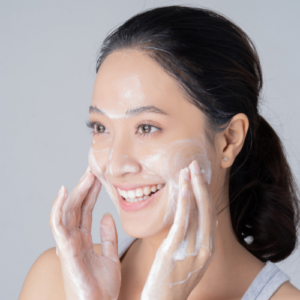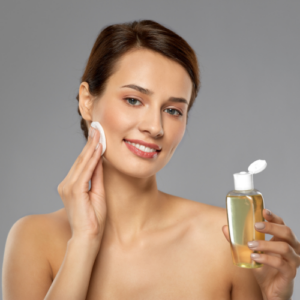Creating a morning skincare routine is an empowering step towards nurturing your skin and boosting your confidence each day. This guide walks you through a simple, step-by-step process tailored to your unique skin type and specific concerns. By establishing a consistent morning ritual, you can enhance your skin’s health, shield it from daily environmental stressors, and set a positive tone for the day ahead. Embrace this opportunity to invest in yourself, as a thoughtful skincare routine can be a source of self-care and rejuvenation.
The table of content
Assess your skin type.
Identify your skin type by observing how your skin feels throughout the day. If your skin appears shiny and feels greasy, especially in the T-zone (forehead, nose, and chin), you likely have oily skin. Notice if your skin feels tight, rough, or flaky, particularly after washing; this indicates dry skin. Recognize combination skin if you experience both oily areas and dry patches, often with an oily T-zone and dry cheeks. If your skin reacts easily to products, becoming red or irritated, then you may have sensitive skin.
Conduct a simple test: cleanse your face and wait for an hour without applying any products. After this time, assess your skin’s condition—this will help you pinpoint whether your skin falls into one of these categories, guiding you in selecting the most suitable skincare products for your routine.
Cleanse your face.
Choose a gentle cleanser that matches your skin type—look for labels that specify whether the product is formulated for oily, dry, or sensitive skin. Apply a small amount of the cleanser to your fingertips, then gently massage it onto your damp face in circular motions, focusing on areas where dirt and oil tend to accumulate. Rinse thoroughly with lukewarm water, ensuring all product is removed. Pat your face dry with a clean towel, avoiding any harsh rubbing to keep your skin fresh and hydrated.

Exfoliate (2-3 times a week).
Choose an exfoliating product that suits your skin type, whether it’s a physical scrub or a chemical exfoliant. If your skin is sensitive, opt for a gentle chemical exfoliator containing ingredients like lactic acid or mandelic acid. Apply the product to clean, damp skin, using circular motions if it’s a physical exfoliant, or a soft cotton pad if you’re using a chemical one. Rinse thoroughly with lukewarm water and follow up with a nourishing moisturizer to keep your skin hydrated and protected.
Apply toner.
Apply toner after cleansing your face to help balance your skin’s pH levels and enhance the absorption of your skincare products. Choose a hydrating toner like a rosewater or hyaluronic acid formula if your skin feels dry or tight. Opt for a clarifying toner containing witch hazel or salicylic acid if you’re dealing with excess oil or breakouts. Use a cotton pad to gently swipe the toner across your skin, ensuring even coverage on your forehead, cheeks, and chin.

Use a serum.
- Choose a serum that specifically addresses your skin concerns, such as brightness, hydration, or anti-aging. Look for key ingredients like vitamin C for brightening, hyaluronic acid for hydration, or retinol for anti-aging.
- Dispense a few drops of the selected serum into your palm.
- Gently press the serum into your skin, starting from the center of your face and moving outward.
- Allow the serum to absorb fully before applying any additional products, like moisturizer or sunscreen.
Moisturize.
Choose a lightweight moisturizer that hydrates your skin without clogging pores. Look for products labeled as “non-comedogenic” or “oil-free” to ensure they won’t block your pores. Ingredients like hyaluronic acid, glycerin, or aloe vera are excellent options for providing hydration without heaviness. Apply it after cleansing and before sunscreen to lock in moisture and maintain your skin’s moisture barrier effectively.
Apply eye cream.
- Squeeze a small amount of eye cream onto your fingertip—about the size of a pea.
- Gently dot the cream around your orbital bone, focusing on areas most affected by puffiness, dark circles, or fine lines.
- Use your ring finger, as it applies the least pressure, and lightly tap the cream into your skin.
- Continue tapping for about 30 seconds, ensuring the product absorbs fully without rubbing or pulling at the delicate skin.
Use sunscreen.
Apply a broad-spectrum sunscreen with at least SPF 30 every morning to shield your skin from harmful UV rays. Choose a sunscreen that offers protection against both UVA and UVB rays, as this will help prevent skin damage and premature aging. Use a generous amount, about a nickel-sized dollop for your face, and remember to cover all exposed areas, including your ears and neck. Reapply every two hours, or more frequently if you’re swimming or sweating, to maintain optimal protection throughout the day.
Makeup application (optional).

- Wait for your skincare products to absorb completely before applying any makeup. This step is crucial to prevent clogging your pores and ensure a smooth application.
- Check the texture of your skin. If it feels tacky or sticky, give it a few more minutes. Proper absorption means your skin should feel soft and dry to the touch.
- Use a light hand when applying foundation. For example, consider a lightweight tinted moisturizer or a water-based foundation to keep your look fresh without overwhelming your skin.
- Apply makeup in thin layers. Start with a small amount of product, like a pea-sized amount of concealer, and gradually build up if necessary. This method helps maintain a natural appearance while allowing your skin to breathe.
Adjust as necessary.
Assess your skin’s condition every season or whenever you notice changes. Observe how your skin reacts to different weather conditions and adjust your routine by incorporating products that cater to its current needs. For instance, switch to a heavier moisturizer in the winter if your skin feels dry, or use a lighter formula in the summer to combat oiliness. Regularly check for any new skin concerns and consult with a dermatologist if needed to ensure you’re using the best products for your skin type.
Embrace your radiant start.
In conclusion, establishing a morning skincare routine is a vital step toward achieving and maintaining healthy, radiant skin. By understanding your skin type and following the tailored steps outlined in this post, you can effectively protect your skin from daily challenges while enhancing its overall appearance. Remember, consistency is key, and as you customize your routine to fit your unique needs, you’ll not only feel great but also boost your confidence each day. Embrace the journey to healthier skin, and enjoy the benefits it brings!
Essential skincare supplies.
-
1.Cleanser
7. Sunscreen
2. Exfoliator 8. Cotton pads or balls
3. Toner
9. Towel
4. Serum
10. Makeup products (optional)
5. Moisturizer
11. Applicator tools (e.g., makeup brushes or sponges, optional) 6. Eye cream
Maximize your glow.
- Assess Your Skin Type: Identify whether your skin is oily, dry, combination, or sensitive to choose the right products
- Cleanse Gently: Start with a gentle cleanser to remove impurities without stripping your skin of its natural oils
- Exfoliate Wisely: If you exfoliate in the morning, opt for a mild chemical exfoliant a few times a week to avoid irritation
- Tone It Down: Use a toner to balance your skin’s pH and prepare it for the products that follow
- Serum Selection: Choose a serum that addresses your specific skin concerns, such as hydration, brightening, or anti-aging
- Moisturize: Apply a lightweight moisturizer to keep your skin hydrated throughout the day
- Sun Protection: Don’t skip sunscreen! Use a broad-spectrum SPF 30 or higher, even on cloudy days
- Stay Consistent: Stick to your routine daily to see the best results over time
- Listen to Your Skin: Pay attention to how your skin reacts and adjust your routine as needed
- Hydrate Inside and Out: Drink plenty of water and consider incorporating hydrating products for maximum benefits
Step-by-step guide to achieve radiant skin every morning.
- Cleanser: Start by washing your face with a gentle cleanser suited to your skin type. This removes dirt and impurities gathered overnight, prepping your skin for the following steps
- Toner: Apply a toner to help balance your skin’s pH levels and remove any leftover cleanser. Look for alcohol-free options to avoid drying out your skin
- Serum: Choose a serum that targets your specific skin concerns, such as hydration or brightening. A few drops applied to your face can make a noticeable difference
- Moisturizer: Follow up with a good moisturizer to lock in hydration. Even if you have oily skin, using a lightweight moisturizer is essential for keeping your skin balanced
- Sunscreen: Finish your routine with sunscreen (SPF 30 or higher). This is crucial for protecting your skin from harmful UV rays, even on cloudy days!
- By following these steps, you’ll be well on your way to healthier skin. Enjoy your skincare journey!
Related: 8 ESSENTIAL STEPS FOR EFFECTIVE DRY SKIN CARE
Skincare Routine: Morning, Night, Skin Types
Essential steps for glowing skin.
How often should I exfoliate in the morning skincare routine?
Exfoliation is an important part of your skincare routine, but how often you should do it can vary based on your skin type and the type of exfoliant you’re using. Generally, if you have sensitive or dry skin, it’s best to exfoliate 1 to 2 times a week. For normal or combination skin, you can typically exfoliate 2 to 3 times a week. If you have oily or acne-prone skin, you might benefit from exfoliating 3 to 5 times a week, but be careful not to overdo it, as that can lead to irritation.
Also, consider the type of exfoliant you’re using: physical exfoliants (like scrubs) can be more abrasive than chemical exfoliants (like AHAs or BHAs), which might allow for more frequent use. It’s always a good idea to listen to your skin and adjust accordingly. If you notice any irritation, scaling, or redness, reduce the frequency. And remember, regardless of how often you exfoliate, always follow up with a good moisturizer and sunscreen!
